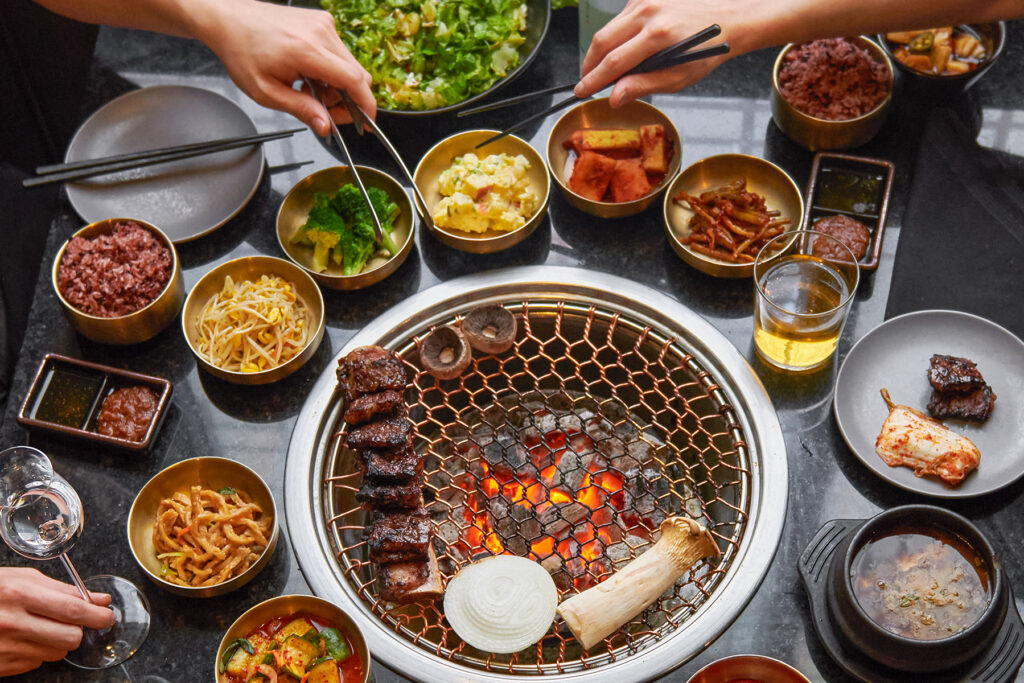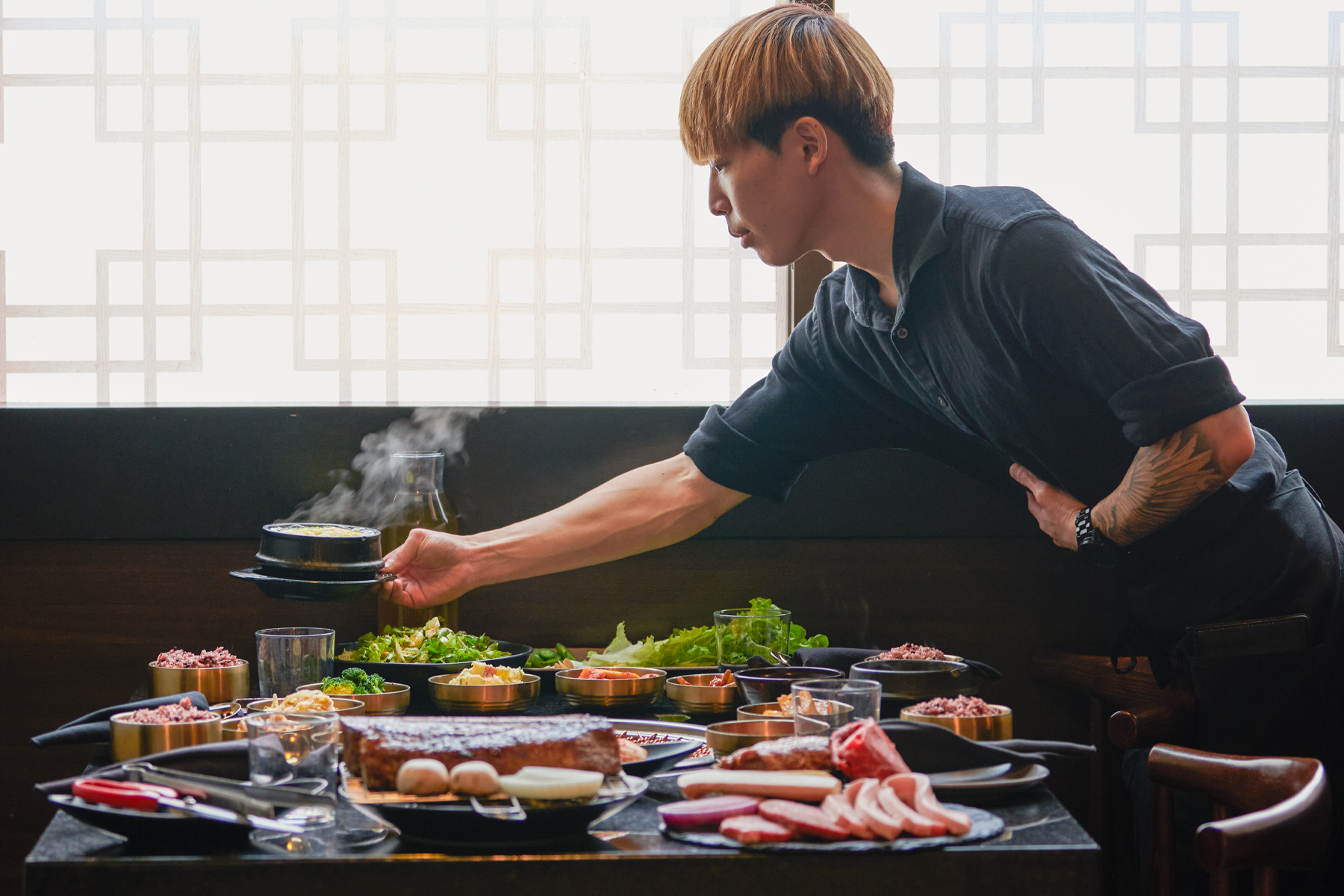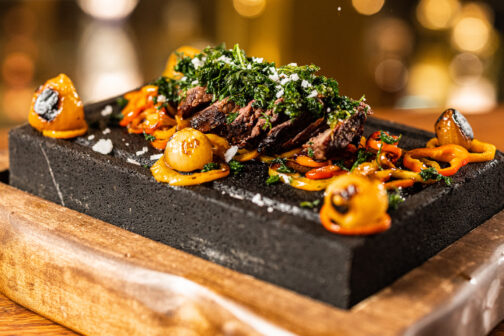Updating a landmark is a delicate task. You’ve got to preserve the tradition but offer something new. You want to please longtime fans but welcome first-timers. A lot can go wrong.
Things were especially tricky in the case of Koryo Korean BBQ, the restaurant on Royal Lane with more than two decades of history under the past names Koryo Kalbi and Chosun Kalbi. Koryo Kalbi closed in 2020, after the owner’s death. Kitchen cooks and other employees moved on to other jobs.
Returning in the pandemic’s wake, the new Koryo faced the ultimate balancing act. Its new owners—the family behind Irving’s Fortune House—found and rehired old employees to maintain the restaurant’s history, but they also gave the interior a stylish remodel. The kitchen serves classic recipes from the old days, but it also has a dry-aging cabinet to turn premium cuts of wagyu beef into high-end Korean barbecue.
Before the pandemic, chefs knew Koryo Kalbi as a BYOB hot spot; they’d turn up after their own kitchens had closed, beer and wine in tow, and party late into the night. Now Koryo serves its own beer, rice wine, and soju.
The changes aren’t quite finished yet. Koryo Korean BBQ reopened with its new name and concept in October and, six months later, was still in what management called “soft opening.” But the reborn restaurant lives up to its predecessor’s reputation and then some.
There are three ways to order at the new Koryo. You could go the traditional route, with a stew, lunch special, or bowl of noodles. You could go all-in on the barbecue, the equipment for which stares up from the center of nearly every table. Or you could attempt both, like the day I ordered the monkfish stew and my friend raised his eyebrow before saying, “OK, but I’m getting the meats.”
A barbecue meal is a sensory rush. First you smell the smoke. Koryo is one of a tiny number of Dallas restaurants that are allowed to grill over charcoal indoors, their permits grandfathered into city code. Then you feel the heat. A server carrying a fresh vessel of glowing oak and hickory charcoal arrives, radiating intense warmth. Every time a new party is seated somewhere in the restaurant, there’s a chance you’ll feel their charcoal pass by before you see it, the heat rippling across your shoulders and back.
Then it’s time for the real excitement to begin. Koryo’s banchan are numerous, superb, and always changing. At one dinner, I counted nine; the next week, there were 11. Koryo’s kimchee is delightfully sharp, striking a balance between the milder forms at some Americanized spots and the deep funkiness of long-aged versions. There could be a terrific cucumber salad with vinegar and red pepper flakes, marinated perilla leaves (handy for making wraps), or hot-pink pickled radishes. Seaweed might arrive in a dressed salad with shredded carrot, or it might be dried out for a crunchy, salty snack.
Don’t eat the banchan too quickly. A barbecue meal comes with shockingly wonderful salad, too: lettuce dressed with vinaigrette, mild gochugaru pepper flakes, and a whole lot of thinly sliced green onions. Oh, and there’s a softly steamed egg omelet served in a sizzling hot skillet, and a small but mighty pot of doenjang jjigae, the comforting soybean-and-tofu soup that’s like miso soup’s distant, heavyweight cousin.
If you hesitate at the price of Koryo’s meats, remember: all of this is included. Your table needs to order at least two kinds of meat, which can easily run $70 to $100. But that one fee gets you a table where there’s barely room for a water glass. Once my table for two counted up 20 different dishes.
Since the restaurant’s dry-aging program is a new signature, we splurged on a portion of aged wagyu rib-eye for $58. Our reward was an inch-thick steak beautifully marbled with thin ribbons of fat. (Once our server had grilled and sliced it, I snapped up a piece so quickly that he jokingly assured us that, yes, beef that rare was safe to eat.) This was undoubtedly a flavorful, fork-soft slice of beef. But those adjectives applied to all the meats. And as the grilling moved on at its busy pace, cuts piled up on our plates until I could no longer tell which was the pride of the house.
At times, a meal can feel like a game of Pac-Man.
Two cuts that do stand out more strongly: the marinated beef short ribs, with the marinade’s unmistakable flavor still fully intact, and the rib fingers. The latter cut is the muscle from between beef back ribs; if you’ve enjoyed beef short ribs, think of fingers as the missing links. Although connective tissue can intrude, the thin strips become effortlessly tender after a couple of minutes over the coals.
But we still have another side of Koryo to explore—the side that doesn’t involve charcoal and smoke. There’s a bowl of bibimbap topped with long, thin strips of beef tartare. There are side orders of thin, chilled buckwheat noodles in two refreshingly light preparations: with delicately sweet beef-and-sesame broth or with a scoop of gently spicy pepper paste. There’s a plate of kimchee fried rice, garnished with a fried egg and seaweed strips, so delicious that I have a new hobby delivering takeout orders to friends.
The old Koryo was long famous for its traditional soups, and they’re back, too. Maeuntang, a monkfish soup, comes with a steak-cut cross section of fish, a bundle of enoki mushrooms, greens, tofu, and a savory, spicy broth that seafood lovers will want by the spoonful. Doenjang jjigae is available in full-meal portions as well.
All of which has led to a transition that has been mostly seamless. Two hiccups should improve when the soft opening phase ends. The first is service speed. When you order barbecue, it all arrives quickly. At times, a meal can feel like a game of Pac-Man; instead of little dots, there’s a constant parade of banchan, noodles, grilled meats, soups, rice, pickles, and lettuce-wrap-making goodies.
In a way this is understandable. If servers are going to preside over the meat cooking, it’s easier to grill your table’s items in one go, rather than drifting off to other tables. And if Koryo served appetizers before the grilled meats arrived, instead of all at once, you’d run the risk of a table getting full and asking for their raw meat to go. So, maybe it truly is best to sit back and enjoy the rush.
The second inconvenience was more serious. In early going, the restaurant’s ventilation system wasn’t working, creating maybe the most smoke-filled dining room since Dallas banned cigarettes in restaurants in 2003. After my friends and I enjoyed a barbecue feast, we all went home and showered to get the charcoal aroma out of our hair.
Thankfully, this problem has been solved. While this review went to press for D‘s print edition, Koryo installed new vents. Everything is working properly now, and private dining rooms are available for parties of six or more.
Now that the smoke has cleared, much has changed, but the most important fact about the old restaurant will still hold true. Koryo Kalbi always had a huge menu, and all of it was good. It was that rarest of things: a master of all trades. The new place is, too. My best advice is to bring a group, over-order, and prepare for the bombardment. Expect the table to fill up. Embrace the overwhelm.
Author










